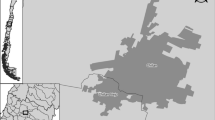Abstract
We conduct predictive validity tests using revealed and stated behavior data from a panel survey of North Carolina coastal households. The application is to hurricane evacuation behavior. Data was initially collected after Hurricane Bonnie led to hurricane evacuations in North Carolina in 1998. Respondents were asked for their behavioral intentions if a hurricane threatened the North Carolina coast during the 1999 hurricane season. Following Hurricanes Dennis and Floyd in 1999, a follow-up survey was conducted to see if respondents behaved as they intended. A jointly estimated revealed and stated behavior model indicates that the hypothetical and real evacuation behavior is based on the same choice process. Using predictions from this model with a hypothetical bias correction, we find that it predicts actual evacuation behavior with a small forecast error. These results suggest that stated behavior data has some degree of predictive validity.
Similar content being viewed by others
References
Avila, L. A. (1998), Preliminary Report: Hurricane Bonnie, 19–30 August 1998. National Hurricane Center http://www.nhc.noaa.gov/1998bonnie.html, October
R. Berrens R. Adams (1998) ArticleTitle‘Using Contingent Valuation to Design Fee Hunting Programs: Oregon Pheasant Hunting Revisited’ Human Dimensions of Wildlife 3 IssueID3 24–38
Beven, J. (2000), Preliminary Report: Hurricane Dennis 24 August–7 September 1999. National Hurricane Center, http://www.nhc.noaa.gov/1999dennis_text.html, January
P. A. Diamond J. A. Hausman (1996) ArticleTitle‘Contingent Valuation: Is Some Number Better than No Number?’ Journal of Economic Perspectives 8 IssueID4 45–64
J. E. Freund R. E. Walpole (1980) Mathematical Statistics EditionNumber3 Prentice-Hall Englewood Cliffs, NJ
W. H. Greene (1999) Econometric Analysis EditionNumber3 Prentice Hall Upper Saddle River, NJ
W. H. Greene (2002) LIMDEP Version 8.0 User’s Manual Econometric Software, Inc Plainview, NY
T. Grijalva R. P. Berrens A. K. Bohara W. D. Shaw (2002) ArticleTitle‘Testing the Validity of Contingent Behavior Trip Responses’ American Journal of Agricultural Economics 84 IssueID2 401–414 Occurrence Handle10.1111/1467-8276.00306
M. K. Haener P. C. Boxall W. L. Adamowicz (2001) ArticleTitle‘Modeling Recreation Site Choice: Do Hypothetical Choices Reflect Actual Behavior?’ American Journal of Agricultural Economics 83 IssueID3 629–642 Occurrence Handle10.1111/0002-9092.00183
W. M. Hanemann (1994) ArticleTitle‘Valuing the Environment through Contingent Valuation’ Journal of Economic Perspectives 8 IssueID4 19–44
N. Hanley D. Bell B. Alvarez-Farizo (2003) ArticleTitle‘Valuing the Benefits of Coastal Water Quality Improvements Using Contingent and Real Behaviour’ Environmental and Resource Economics 24 IssueID3 273–285 Occurrence Handle10.1023/A:1022904706306
J. A. List C. A. Gallet (2001) ArticleTitle‘What Experimental Protocol Influence Disparities Between Actual and Hypothetical Values?’ Environmental and Resource Economics 20 IssueID3 241–254 Occurrence Handle10.1023/A:1012791822804
J. B. Loomis (1993) ArticleTitle‘An Investigation in the Reliability of Intended Visitation Behavior’ Environmental and Resource Economics 3 IssueID2 183–191 Occurrence Handle10.1007/BF00338784
Pasch, R. J., T. B. Kimberlain and S. R. Stewart (2000), Preliminary Report: Hurricane Floyd, 7–17 September 1999. National Hurricane Center, http://www.nhc.noaa.gov/1999floyd_ text. html, January
Tropical Prediction Center (1999), The Saffir-Simpson Hurricane Scale. National Hurricane Center, http://www.nhc.noaa.gov/aboutsshs.html, July 14
J. C. Whitehead (2003) ArticleTitle‘One Million Dollars per Mile? The Opportunity Costs of Hurricane Evacuation’ Ocean and Coastal Management 46 IssueID11–12 1069–1083 Occurrence Handle10.1016/j.ocecoaman.2003.11.001
J. C. Whitehead B. Edwards M. Willigen ParticleVan J. R. Maiolo K. Wilson K. T. Smith (2000) ArticleTitle‘Heading for Higher Ground: Factors Affecting Real and Hypothetical Hurricane Evacuation Behavior’ Environmental Hazards 2 IssueID3 133–142 Occurrence Handle10.1016/S1464-2867(01)00013-4
Author information
Authors and Affiliations
Corresponding author
Rights and permissions
About this article
Cite this article
Whitehead, J.C. Environmental Risk and Averting Behavior: Predictive Validity of Jointly Estimated Revealed and Stated Behavior Data. Environ Resource Econ 32, 301–316 (2005). https://doi.org/10.1007/s10640-005-4679-5
Accepted:
Issue Date:
DOI: https://doi.org/10.1007/s10640-005-4679-5




